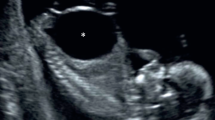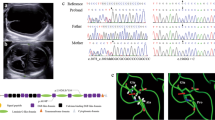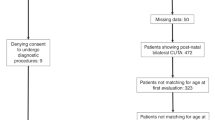Abstract
Objective:
Renal malformations can be associated with genetic syndromes and chromosomal disorders. Fetal autopsy including histopathological examination of kidney is important to arrive at definite diagnosis. The objective was to assess importance of fetal autopsy and histopathology.
Study Design:
Retrospective analysis of cases with fetal renal malformations was done. All fetuses terminated were examined with whole body radiograph, external and internal examination and histopathological examination.
Result:
A total of 21 cases with renal malformations were studied. Of all 3 were of bilateral renal agenesis, 4 showed autosomal recessive polycystic kidney disease and 13 showed features of multicystic kidney. Three of these had hyperplasic-enlarged bladder and autopsy confirmed urorectal septum malformations in two cases and posterior urethral valve in one case. One case had associated malformations like encephalocele that suggested diagnosis of Meckel–Gruber syndrome and another had associated lateral body wall defect. In five cases kidney was hypoplastic suggestive of Potter type IIa.
Conclusion:
Ultrasound is an effective diagnostic modality; however fetal autopsy after termination of pregnancy is important to arrive at a definitive diagnosis. It's important to distinguish between autosomal recessive polycystic kidney disease (ARPKD) and cystic dysplastic kidney as recurrence risk is 3% in case of cystic renal dysplasia in contrast to 25% in case of ARPKD. Gross examination may point toward syndromic diagnosis like Meckel–Gruber syndrome; hence mode of prenatal diagnosis may vary in subsequent pregnancies.
This is a preview of subscription content, access via your institution
Access options
Subscribe to this journal
Receive 12 print issues and online access
$259.00 per year
only $21.58 per issue
Buy this article
- Purchase on Springer Link
- Instant access to full article PDF
Prices may be subject to local taxes which are calculated during checkout





Similar content being viewed by others
References
Wiesel A, Queisser-Luft A, Clementi M, Bianca S, Stoll C, EUROSCAN Study Group. Prenatal detection of congenital renal malformations by fetal ultrasonographic examination: an analysis of 709 030 births in 12 European countries. Eur J Med Genet 2005; 48 (2): 131–144.
Zhou Q, Ji ZZ, Cardoza J . Value of ultrasound in the diagnosis of congenital renal malformations. Di Yi Jun Yi Da Xue Xue Bao 2005; 25 (9): 1086–1089.
Vanderheyden T, Kumar S, Fisk NM . Fetal renal impairment. Semin Neonatol 2003; 8 (4): 279–289.
Wilcox DT, Chitty LS . Non-visualization of fetal bladder: aetiology and management. Prenat Diagn 2001; 21: 977–983.
Klaassen I, Neuhaus TJ, Mueller-Wiefel DE, Kemper MJ . Antenatal oligohydramnios of renal origin: long-term outcome. Nephrol Dial Transplant 2007; 22 (2): 432–439.
Schwaderer AL, Bates CM, McHugh KM, McBride KL . Renal anomalies in family members of infants with bilateral renal agenesis/adysplasia. Pediatr Nephrol 2007; 22 (1): 52–56. Epub 2006 Sep 15.
Wellesley D, Howe DT . Fetal renal anomalies and genetic syndromes. Prenat Diagn 2001; 21: 992–1003.
Winyard P, Chitty L . Dysplastic and polycystic kidneys: diagnosis, associations and management. Prenat Diagn 2001; 21 (11): 924–935. Review.
Menezes LF, Onuchic LF . Molecular and cellular pathogenesis of autosomal recessive polycystic kidney disease. Braz J Med Biol Res 2006; 39 (12): 1537–1548 (Review).
Zerres K, Senderek J, Rudnik-Schöneborn S, Eggermann T, Kunze J, Mononen T et al. New options for prenatal diagnosis in autosomal recessive polycystic kidney disease by mutation analysis of the PKHD1 gene. Clin Genet 2004; 66 (1): 53–57.
Bergmann C, Senderek J, Schneider F, Dornia C, Küpper F, Eggermann T et al. PKHD1 mutations in families requesting prenatal diagnosis for autosomal recessive polycystic kidney disease (ARPKD). Hum Mutat 2004; 23 (5): 487–495.
Rottenberg GT, Gordon I, De Bruyn R . The natural history of the multicystic dysplastic kidney in children. Br J Radiol 1997; 70 (832): 347–350.
He R, Harrison K, Malloy C, Mc Clatchey KD . Pathologic quiz case; multiple congenital birth defects in a full-term infant. Arch Pathol Lab Med 2004; 128: e73–e75.
Patil SJ, Phadke SR . Urorectal septum malformation sequence: Ultrasound correlation with fetal examination. Indian J Pediatr 2006; 73 (4): 287–293.
Lazebnik N, Bellinger MF, Ferguson II JE, Hogge JS, Hogge WA . Insights into the pathogenesis and natural history of fetuses with multicystic dysplastic kidney disease. Prenat Diagn 1999; 19 (5): 418–423.
Mittermayer C, Lee A, Brugger PC . Prenatal diagnosis of the Meckel–Gruber syndrome from 11th to 20th gestational week. Ultraschall Med 2004; 25 (4): 275–279.
Alexiev BA, Lin X, Sun CC, Brenner DS . Meckel–Gruber syndrome: pathologic manifestations, minimal diagnostic criteria, and differential diagnosis. Arch Pathol Lab Med 2006; 130 (8): 1236–1238.
Ng JW, Kong CK, Wong MK, Book KS . Familial gastroschisis in siblings is rare. J Pediatr Surg 1994; 29 (12): 1637–1638.
Salvesen KÅ . Fetal abdominal wall defects—easy to diagnose—and then what? Ultrasound Obstetr Gynecol 2001; 18 (4): 301–304.
Rudnik-Schoneborn S, John U, Deget F, Ehrich JH, Misselwitz J, Zerres K . Clinical features of unilateral multicystic renal dysplasia in children. Eur J Pediatr 1998; 157 (8): 666–672.
Argueso LR, Ritchey ML, Boyle Jr ET, Milliner DS, Bergstralh EJ, Kramer SA . Prognosis of patients with unilateral renal agenesis. Pediatr Nephrol 1992; 6 (5): 412–416.
McHale D, Porteous ME, Wentzel J, Burn J . Further evidence of genetic heterogeneity in hereditary hydronephrosis. Clin Genet 1996; 50 (6): 491–493.
Author information
Authors and Affiliations
Corresponding author
Rights and permissions
About this article
Cite this article
Kumari, N., Pradhan, M., Shankar, V. et al. Post-mortem examination of prenatally diagnosed fatal renal malformation. J Perinatol 28, 736–742 (2008). https://doi.org/10.1038/jp.2008.93
Received:
Revised:
Accepted:
Published:
Issue Date:
DOI: https://doi.org/10.1038/jp.2008.93
Keywords
This article is cited by
-
A Spectrum of Congenital Anomalies of the Kidney and Urinary Tract (CAKUT)—Diagnostic Utility of Perinatal Autopsy
Indian Journal of Pediatrics (2023)
-
Added value of fetal MRI as a complementary method to antenatal ultrasound in the assessment of non-CNS fetal congenital anomalies
Egyptian Journal of Radiology and Nuclear Medicine (2022)
-
Perinatal post-mortem ultrasound (PMUS): radiological-pathological correlation
Insights into Imaging (2019)
-
Termination of pregnancy for renal malformations
Pediatric Nephrology (2015)



